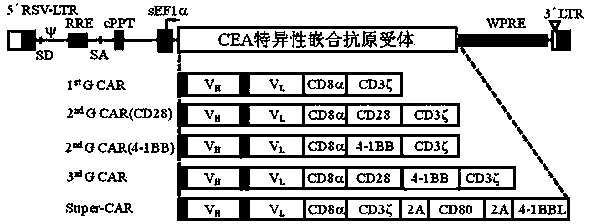Chimeric antigen receptor, coding gene, expression vector and application thereof
A technology of chimeric antigen receptors and coding genes, which is applied in the field of chimeric antigen receptors, expression vectors, and coding genes to achieve the effects of enhancing specificity, enhancing killing activity, and enhancing activity
- Summary
- Abstract
- Description
- Claims
- Application Information
AI Technical Summary
Problems solved by technology
Method used
Image
Examples
Embodiment 1
[0034] Taking carcinoembryonic antigen (CEA) as an example, the CEA-specific ScFv (CEA)-CD8α-CD3ζ-2A-CD80-2A-4-1BBL gene fragment was obtained through in vitro synthesis and molecular cloning methods. Wherein, the nucleotide sequence of the ScFv (CEA) gene includes the signal leader region, the V H Fragment, Linker(GGGGS)3 and V LFragment, the nucleotide sequence of which is shown in SEQ NO.1-4. The nucleotide sequence of the CD8α transmembrane region gene is shown in SEQ NO.5. The nucleotide sequence of the CD3ζ signal region gene is shown in SEQ NO.6. The nucleotide sequence of the 2A-CD80-2A-4-1BBL gene sequentially includes a T2A fragment, a CD80 fragment, a F2A fragment, and a 4-1BBL fragment, and its nucleotide sequence is shown in SEQ NO.7-10.
Embodiment 2
[0036] The scFv (CEA)-CD8α-CD3ζ-2A-CD80-2A-4-1BBL gene fragment was introduced into the lentiviral vector pRRL to obtain a lentiviral vector carrying the Super-CAR gene: the ScFv-CD8α-CD3ζ- The 2A-CD80-2A-4-1BBL gene fragment and the lentiviral vector pRRL were double digested with the same restriction endonuclease to recover the DNA fragments; the recovered DNA fragments were ligated by ligase.
[0037] Similarly, use the same method to construct lentiviral vectors of the first, second and third generation CARs with the CEA single-chain antibody gene, such as figure 1 As shown, among them, 1 st G CAR lentiviral vector is the first generation chimeric antigen receptor, 2 nd G CAR (CD28) is a second-generation chimeric antigen receptor carrying CD28 co-stimulatory molecules, 2 nd G CAR (4-1BB) is a second-generation chimeric antigen receptor carrying 4-1BB co-stimulatory molecules, 3 rd G CAR is the third-generation chimeric antigen receptor, and Super-CAR is a novel chi...
Embodiment 3
[0042] The lentiviral vectors constructed above carrying different CAR genes were transiently transfected into 293T cells. After 48 h, the cells were lysed, and the expression of the CD3ζ intracellular signal region was detected by Western blot. The results were as follows: image 3 shown. Among them, 1: 293T cells transfected with empty vector; 2: transfected with 1 st G CAR vector cells; 3: transfection 2 nd Cells with G CAR (CD28) vector; 4: transfection 2 nd Cells with G CAR (4-1BB) vector; 5: transfection 3 rd G CAR vector cells; 6: cells transfected with Super-CAR vectors. 293T cells themselves do not express CD3ζ. After transfection, the intracellular signal region of CD3ζ that meets the expected size can be detected, and the size is correct, indicating that the recombinant lentiviral vector after transfection is correctly expressed in human cells.
PUM
 Login to View More
Login to View More Abstract
Description
Claims
Application Information
 Login to View More
Login to View More - R&D
- Intellectual Property
- Life Sciences
- Materials
- Tech Scout
- Unparalleled Data Quality
- Higher Quality Content
- 60% Fewer Hallucinations
Browse by: Latest US Patents, China's latest patents, Technical Efficacy Thesaurus, Application Domain, Technology Topic, Popular Technical Reports.
© 2025 PatSnap. All rights reserved.Legal|Privacy policy|Modern Slavery Act Transparency Statement|Sitemap|About US| Contact US: help@patsnap.com



